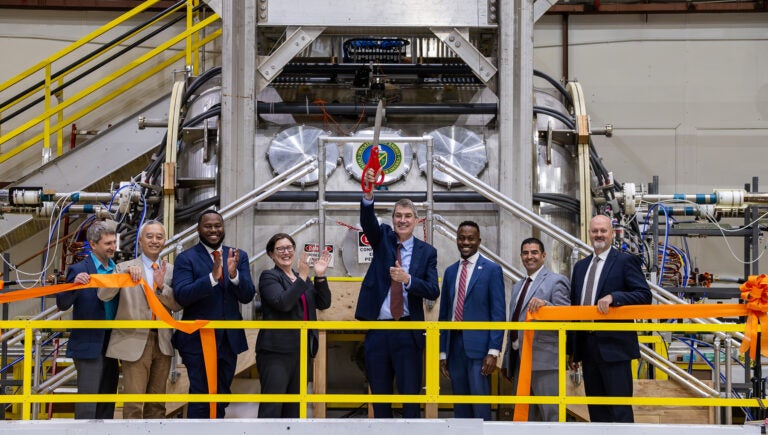Princeton physics experiment aims to shed light on disruptive solar flares
The multimillion-dollar experiment that was years in the making comes as the federal government makes broad cuts to science elsewhere.
Listen 1:53
Dignitaries formally inaugurate the beginning of FLARE operations. From left: Vyacheslav (Slava) Lukin; Hantao Ji, PPPL physicist and FLARE’s principal investigator; Brandon Thorne, director of Princeton University’s Office of the Vice President for PPPL; Jennifer Rexford, provost of Princeton University; Steve Cowley, PPPL director; Christian Newton, chief of staff at the DOE’s Office of Science; J.P. Allain, associate director of Fusion Energy Sciences for the DOE’s Office of Science; Michael Ford, PPPL associate laboratory director for engineering (Michael Livingston / PPPL communications department)
From Philly and the Pa. suburbs to South Jersey and Delaware, what would you like WHYY News to cover? Let us know!
A multimillion-dollar science experiment at the Princeton Plasma Physics Laboratory started operations after years of construction.
The Facility for Laboratory Reconnection Experiments, or FLARE, studies a phenomenon called magnetic reconnection. This happens on the surface of the sun, when magnetic fields change in such a way that causes explosions called solar flares. Those explosions send off charged particles that can hit Earth’s atmosphere, causing the northern lights, but they can also disrupt power grids, satellites, and GPS systems that pilots and farmers rely on.
One recent and notable disruption happened in May of last year, in the middle of planting season for midwestern states. It disabled the satellites that guide the exact placement of corn seeds, delaying planting and leading to an estimated $500 million in losses due to lower corn yields.
Crucially, scientists do not yet understand why and when solar flares happen. Scientists can already study solar flares by staring at the sun’s surface, “waiting for magic to happen”, but a “natural phenomenon is very hard to control,” said plasma physicist Hantao Ji, one of the lead scientists.
Instead, this new experiment would study magnetic reconnection during solar flares by recreating them on a small scale in the facility that looks like a metal barrel around the size of an SUV. This effort builds on a previous experiment at the same lab called the Magnetic Reconnection Experiment, which ran for decades. However, the new experiment is larger and would allow scientists to get closer to understanding what happens at the sun, said Ji, who also worked on the previous experiment.

Hopefully, scientists will eventually understand solar flares well enough to predict when they will happen, so as to protect satellites and other important infrastructure, said Ji.
The Department of Energy supports this experiment as one of its priorities, at a time when the Trump administration has cut millions of dollars of research funding from the National Science Foundation and the National Institutes of Health, and has proposed even more cuts.
The department supports this experiment because it is also useful for the study of nuclear fusion — the process that powers the sun and could also potentially generate vast amounts of cheap electricity on Earth.
Ji explained that the kinds of magnetic reconnections that happen in the sun could also occur inside a nuclear fusion device, so it is essential to understand the process in order to design fusion devices safely.
Nuclear fusion is a goal that scientists have dreamed of achieving since the 1930s, but have yet to reach. This is a priority for the current Department of Energy, said Christian Newton, chief of staff at the department’s Office of Science.
“What is it going to take to really harness fusion energy and one day get that to the grid? FLARE … contributes to that massively,” Newton said. “FLARE is going to allow us to … dive into the secretary’s priorities of … making energy more affordable.”

The start of the new experiment, FLARE, is indeed something to celebrate, said Asmeret Asefaw Berhe, the previous director of the Department of Energy’s Office of Science, and a professor of soil biogeochemistry at the University of California, Merced. She points out that FLARE is twice the size as the previous experiment, and allows scientists to recreate conditions akin to those in space, here on Earth.
“I celebrate an accomplishment like this, but I also have to remember that the administration’s proposed budget includes dramatic reductions in science funding across agencies,” she said. “While we’re happy to … showcase projects like FLARE, it is important that we do not simultaneously cut millions and the foundation of scientific progress in the nation and in the world. The proposed cuts are not minor adjustments. There’s substantial cuts to critical areas, including health research, climate science and so many other basic research, as well as applied research areas.”
She added that the U.S. has invested in science for decades to achieve the kind of leadership position it has now, but “it can be destroyed in a single budget cycle.”
She hopes the U.S. can continue the bipartisan tradition of supporting the scientific ecosystem and “avoid politicizing science funding decisions because the consequences of doing so go far, far beyond … specific laboratories, research institutions or universities, they continue and they will continue to impact our economy, public health, national security, and so much more.”
Princeton University, which manages the Princeton Plasma Physics Laboratory, is one of several universities that the Trump administration has specifically targeted with cuts to federal funding.
It’s fortunate that FLARE was able to continue because “science is under threat all over the nation,” said Dylan Spaulding, a physicist and senior scientist at the Union of Concerned Scientists’ Global Security Program.

Get daily updates from WHYY News!
WHYY is your source for fact-based, in-depth journalism and information. As a nonprofit organization, we rely on financial support from readers like you. Please give today.







